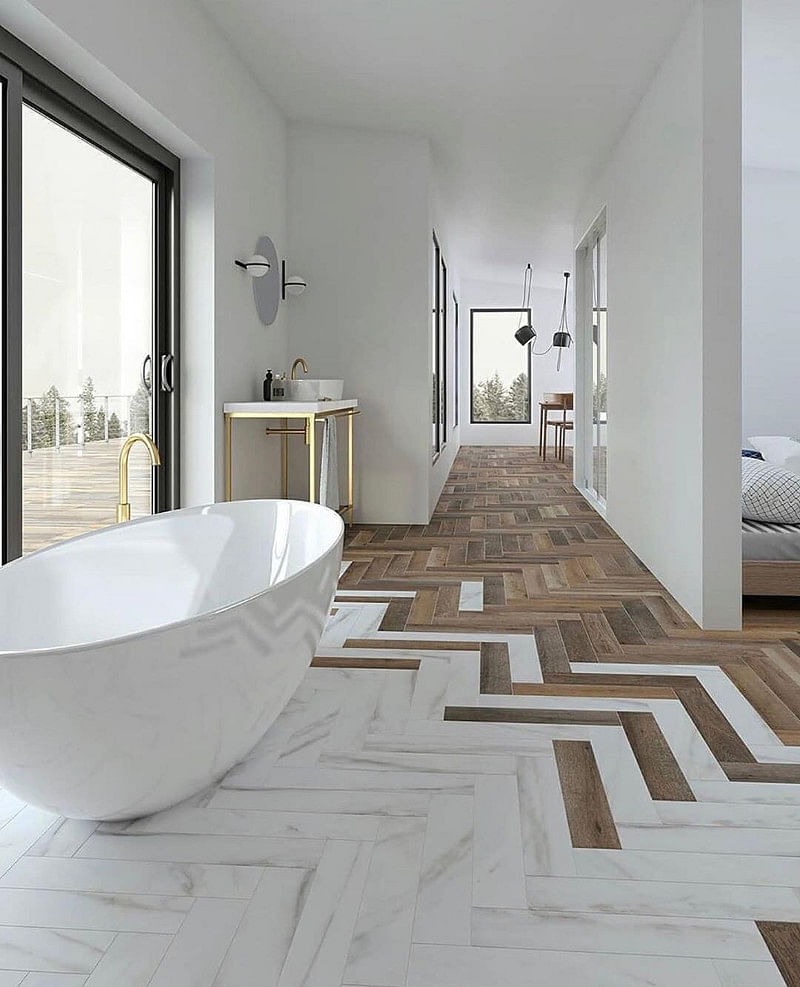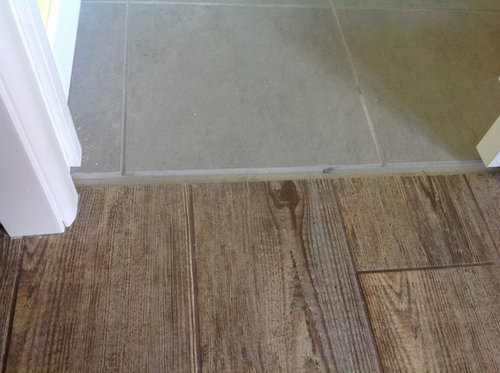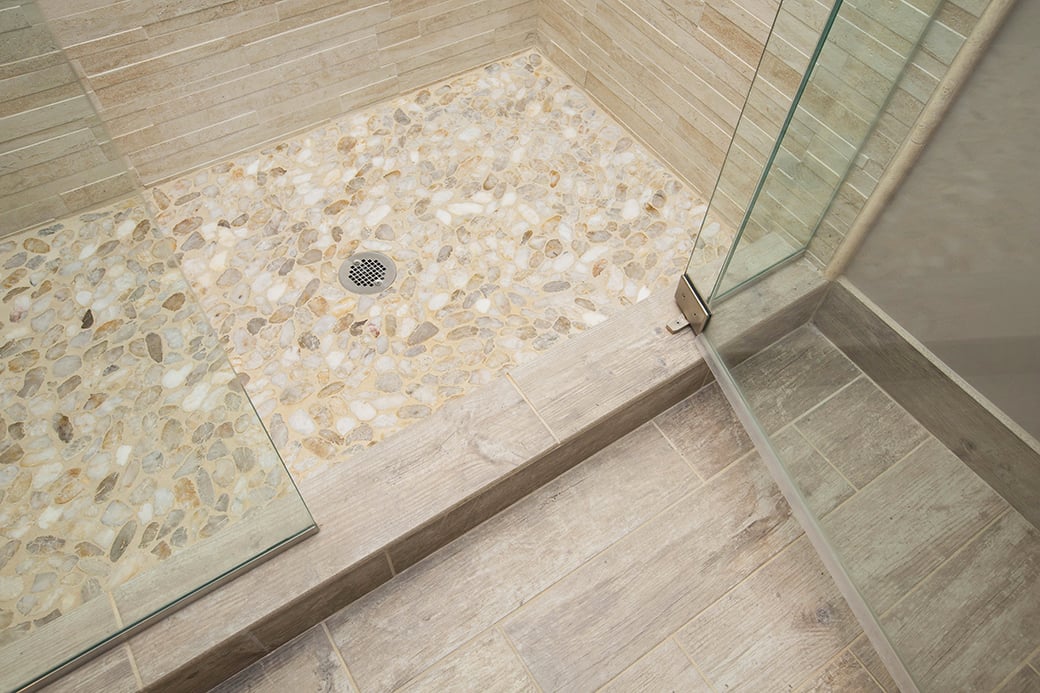Bathroom tile transition refers to the process of seamlessly joining two different types or styles of tiles in a bathroom space. This transition is necessary when transitioning between different materials, sizes, colors, or patterns of tiles, such as from ceramic to porcelain, large format to mosaic, or from one color or pattern to another. Properly executed tile transitions not only enhance the aesthetic appeal of the bathroom but also contribute to its functionality by creating smooth and safe surfaces for walking and cleaning.
There are several common methods for achieving a smooth and visually appealing tile transition in a bathroom. One popular technique is using transition strips or profiles made of materials like metal, plastic, or wood, which are installed along the edges of the tiles to create a seamless transition between them. These transition strips come in various shapes, sizes, and finishes to match the design and style of the tiles and provide a clean and polished look to the transition area.
Another method for creating a seamless tile transition is by using grout or caulking to fill in the gaps between the tiles. This technique is particularly useful when transitioning between tiles of similar sizes or materials, where transition strips may not be necessary. Grout or caulking can be color-matched to the tiles to create a cohesive look or contrasted to create a visually striking effect, depending on the desired aesthetic.
In addition to transition strips and grout, there are other creative ways to achieve a smooth and visually appealing tile transition in a bathroom. For example, using decorative borders, accent tiles, or mosaic patterns can help to delineate different areas of the bathroom while adding visual interest and style to the space. Alternatively, incorporating a gradual transition by gradually changing the size, color, or pattern of the tiles can create a subtle and seamless transition between different areas of the bathroom.
When planning a bathroom tile transition, it’s essential to consider factors such as the layout of the bathroom, the types of tiles being used, and the overall design aesthetic. Proper planning and execution of the tile transition will ensure a cohesive and visually appealing look that enhances the overall design of the bathroom while providing functionality and durability for years to come.
Bathroom tile transition is a crucial aspect of bathroom design that involves seamlessly joining different types or styles of tiles to create a cohesive and visually appealing look. Whether using transition strips, grout, decorative borders, or other creative techniques, a well-executed tile transition enhances the aesthetic appeal and functionality of the bathroom space. By carefully considering factors such as layout, tile types, and design aesthetic, homeowners can achieve a seamless and visually striking tile transition that enhances the overall design of their bathroom.
How to Tile a Bathroom FloorNext to Curbless Showers
Guest bathroom tile floor to hallway hardwood transition. Tile
Stylish Floor Transition Ideas That Catch the Eye in 2024
For Floors Profiles schluter.com
How to handle a 2″ step into bathroom? – Home Improvement Stack
Tile Transition and Border For the Home Pinterest Bathroom
Transition Strips
How to Finish the Tile Edge in a Shower With No Bullnose
Trends in Bathroom Tile Design
Ideas on how to transition from one color ceramic tile to another
Related articles:
- Restore Old Bathroom Tile
- Rustic Bathroom Tile Designs
- Vertical Bathroom Tile Designs
- Bathroom Tile Makeover
- Modern Bathroom Tile Ideas
- Blue Glass Mosaic Bathroom Tiles
- Bathroom Tile Shower Design Ideas
- Modern Bathroom Tile Texture
- Modern Bathroom Tile Layout
- Bathroom Tiles Painted Over
Bathroom Tile Transition: A Comprehensive Guide
When it comes to bathroom renovations, one of the most important aspects to consider is the transition between different types of flooring. Bathroom tile transition refers to the area where two different types of flooring meet, such as tile and hardwood or tile and carpet. A properly executed transition can make all the difference in the overall look and feel of your bathroom. In this article, we will discuss everything you need to know about bathroom tile transition, including different types of transitions, installation methods, and frequently asked questions.
Types of Bathroom Tile Transitions
There are several types of bathroom tile transitions to consider when planning your renovation project. Each type serves a different purpose and has its unique benefits.
Straight Edge Transition
A straight edge transition is the simplest type of transition that can be used in a bathroom. It involves placing a flat metal strip between two different types of flooring. It is a popular option because it is easy to install and affordable.
T-Molding Transition
T-molding is a type of transition that is used when two floors with different heights meet, such as tile and hardwood. The T shape of the molding allows for a gradual shift between the two floors. T-molding can be made from wood, metal or vinyl.
Reducer Transition
A reducer transition is used when two floors with different heights meet and one floor is higher than the other. It creates a slope between the two floors, allowing for a smooth transition between them. Reducer transitions are typically made out of wood or vinyl.
Threshold Transition
A threshold transition is used when there is a door between two rooms with different types of flooring. It creates a barrier between the two rooms while still allowing for easy access through the doorway. Thresholds can be made from wood or metal.
Installation Methods for Bathroom Tile Transitions
Installing bathroom tile transitions involves more than just laying down strips of metal or wood between two different types of flooring. Proper installation is essential for a seamless and durable transition.
Planning
Before installing any type of bathroom tile transition, it is important to plan out the layout of the room and where the transitions will be placed. This will help ensure that everything fits properly and looks cohesive.
Preparing the Subfloor
The subfloor must be clean, flat and free from debris before any type of transition can be installed. If the subfloor is uneven, it may need to be leveled before installation can begin.
Cutting the Transition
The transition must be cut to fit the space between the two floors precisely. A saw or a pair of heavy-duty snips can be used to make accurate cuts.
Installing the Transition
Once the transition has been cut to size, it can be installed using screws, adhesive or both. The method used will depend on the type of transition being installed.
How do I choose the right type of bathroom tile transition for my renovation project?
The type of bathroom tile transition you choose will depend on several factors, including the types of flooring you are using, the height difference between them, and your personal style preferences. Consult with a professional contractor to determine which option is best for your project.
Can I install bathroom tile transitions myself?
While it is possible to install bathroom tile transitions yourself, it is recommended that you consult with a professional contractor for best results. Improper installation can lead to gaps or unevenness in the transition, which can create tripping hazards and detract from the overall look of your renovation project.
What materials are best for bathroom tile transitions?
Bathroom tile transitions can be made from several materials, including wood, metal or vinyl. Each material has its unique benefits and drawbacks. Consult with a professional contractor to determine which material is best for your project.
How can I ensure that my bathroom tile transition is durable?
Proper installation and maintenance are essential for a durable bathroom tile transition. Make sure that the transition is installed correctly and that it is properly cleaned and maintained over time.
Bathroom tile transition is an important aspect of any renovation project. It helps create a seamless and cohesive look between different types of flooring while also providing a safe and functional transition between rooms. By understanding the different types of transitions available, installation methods, and frequently asked questions, you can make informed decisions about your renovation project and achieve the desired results. Consult With a professional contractor for best results and to ensure that your bathroom tile transition is installed correctly and will be durable over time. With the right planning and materials, you can create a beautiful and functional space that will enhance the value of your home.











